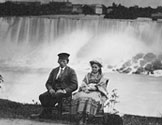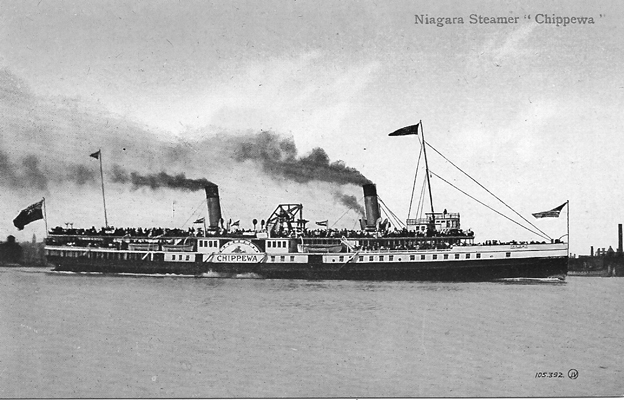

|
||||||||||||||||||||||||||||||||||||||||||
|
| ||||||||||||||||||||||||||||||||||||||||||
 |
 |
 |
 |
 Niagara Navigation Company Steamships  When we think of paddle-wheel steamships, our thoughts usually turn to the smoke-belching vessels on the Mississippi or the Hudson. Many do not realize that Niagara County was also the home port for several very successful steamships that plied the Niagara River and the Great Lakes. The Niagara Navigation Company began business in 1878, carrying passengers and freight with a fleet of at least six steamers that ran between Toronto, Niagara-on-the-Lake and Lewiston. Their first vessel was the Chicora, an Indian word meaning “The Pretty Flower.” The ship was a large steel side-wheel steamer, 230 feet long and 52 feet wide. The first officer placed in command of this popular vessel was Captain Thomas Harbottle, described as a popular man as well as a clever and experienced sailor. The Chicora worked the route by itself for ten years, until 1888, when the Cibola, a paddle-steamship, was placed in service upon the same route. Construction of the Cibola (“Land of the Buffalo”) was begun on May 24, 1887. The ship was designed for stability and speed. The hull was divided into five compartments with water tight bulkheads. The engines had two cylinders with a stroke of 5 feet 6 inches. The interior cabins were finished in solid mahogany and electric lights were used throughout. The dining room and main cabin were decorated with cut glass and “opalescent globes.” A brass chandelier hung above the stairway with “jeweled openings and clusters of lights.” The Cibola met a tragic fate and burned while lying in port at Lewiston, July 15th, 1895. Tragically, one life was lost, that of the third engineer, William Hammond. Also at the end of the 1880s, a small steamer known as the Ongiara (“Thundering Water,”) joined the fleet on the Niagara River, plying a short route from Niagara-on-the-Lake in Canada to Lewiston on the American side. The Ongiara worked this round-robin route and connected with steamers from Toronto. The next ship in the Niagara Navigation fleet was the Chippewa, which made her first trip on July 26, 1893. The ship was named after a famous man-of-war on the Great Lakes during the War of 1812 (which took the name of the famous Indian chief). Like the Cibola, the Chippewa was a floating palace. Written accounts stated, “her appointments, machinery and general finish (are) as nearly as possible approaching perfection.” The Chippewa was 311 ft. in length with a side-wheel similar to the plan of the Hudson River steamers. The ship’s main cabin was 192 ft. long and there were four large state rooms in birch, oak and mahogany. The arrival of the twentieth century ushered in great changes in the way people traveled. The automobile, with its speedy short hops, made steamship travel obsolete for all but very long oceanic trips. People were not interested in spending a day traveling by steamship, when the same distance could be traveled in a couple of hours in one’s own car. “The Chevrolet” became everyman’s “luxury vessel,” bringing an end to the opulent era of Niagara Navigation Company steamships. Douglas Farley, Director Ann Marie Linnabery Erie Canal Discover Center 24 Church St. Lockport NY 14094 716.439.0431 CanalDiscovery@aol.com www.NiagaraHistory.org |